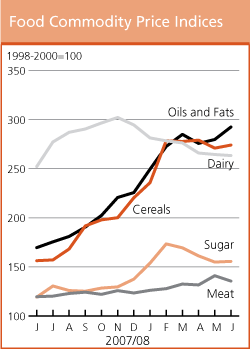No.3  July 2008 July 2008 | ||
 |
Crop Prospects and Food Situation | |
|
FAO food price indicesThe FAO Food Price Index averaged 216 in June 2008, virtually unchanged from May as reductions in meat and dairy prices were offset by increases in export prices of cereals as well sugar and vegetable oils. At its June 2008 value, the FAO food price index was below its peak in March, but still be 44 percent above the June 2007 level. The FAO Cereal Index averaged 274 in June, slightly higher than in May, driven by record maize prices, following reports of cuts in plantings and flood damage in the United States, the world’s largest producer and exporter of maize. The maize price strength also pushed up wheat prices while rice quotations tended to weaken as new crops were harvested in exporting countries. The index has gained 16 percent since January and is now 75 percent above the value in June last year. The FAO Oils/Fats Index averaged 283 in the second quarter of 2008, respectively 76 percent and 151 percent above the corresponding values in 2007 and 2006. Steady expansion in the demand for vegetable oils and fats combined with slow production growth has led to a tightening of global supplies, thus pushing up prices. After a relative stabilization in April and May 2008, the index resumed growth in June, reaching a new record of 292 points, as prospects for a marked recovery in global oilseed production in 2008/09 have diminished. New price hikes for maize and crude oil are also contributing to the strengthening in prices for oilseeds and derived products. The FAO Meat Index has risen considerably since the beginning of 2008 but showed signs of weakening between May and June when it fell to 135. While strong demand and high feeding costs have contributed to the rise in meat prices, increased slaughtering rates are expected to put prices under pressure at least in the short-term. The FAO Dairy Index averaged 263 in June, which is 4 percent higher than in June 2007, but down 13 percent from its peak in November 2007, reflecting a weakening of import demand following production increases in traditional importing countries. Uncertainty remains concerning the export supplies from Oceania, which is containing the drop in milk product prices. The FAO Sugar Index in the first six months of 2008 averaged 161, up 25 percent from the corresponding value in 2007. After increasing through February, prices came down considerably in April and May, but regained some momentum in June mainly because of the anticipated lower world sugar production in the 2008/09 season. 

|
||||||||||||||||||||||||||||||||||||||||||||||||||||||||||||||||||||||||||||||||||||||||||||||||||||||||||||||||||||||||||||||||||||||||||||||||||||||||||||||||||||||||||||||||||||||||||||||
| GIEWS | global information and early warning system on food and agriculture |